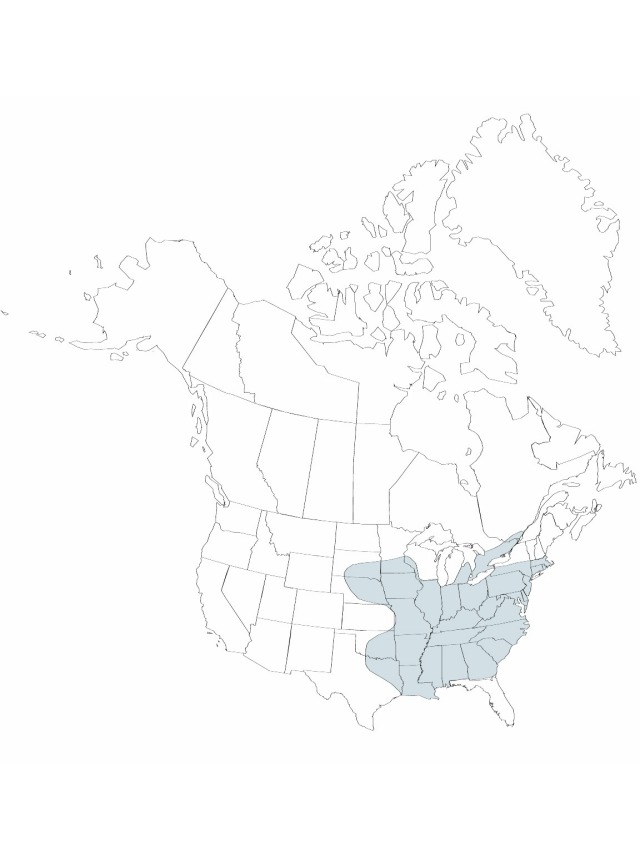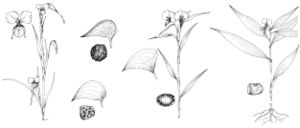Difference between revisions of "Commelina communis"
Sp. Pl. 1: 40. 1753.
FNA>Volume Importer |
FNA>Volume Importer |
||
| Line 23: | Line 23: | ||
|habitat=Weedy and waste places, edges of fields, woods, and marshes, often in thick herbaceous vegetation, occasionally in woods | |habitat=Weedy and waste places, edges of fields, woods, and marshes, often in thick herbaceous vegetation, occasionally in woods | ||
|distribution=Ont.;Que.;Ala.;Ark.;Conn.;Del.;D.C.;Ga.;Ill.;Ind.;Iowa;Kans.;Ky.;La.;Md.;Mass.;Mich.;Minn.;Miss.;Mo.;Nebr.;N.J.;N.Y.;N.C.;Ohio;Okla.;Pa.;R.I.;S.C.;S.Dak.;Tenn.;Tex.;Va.;W.Va.;Wis.;native;Asia. | |distribution=Ont.;Que.;Ala.;Ark.;Conn.;Del.;D.C.;Ga.;Ill.;Ind.;Iowa;Kans.;Ky.;La.;Md.;Mass.;Mich.;Minn.;Miss.;Mo.;Nebr.;N.J.;N.Y.;N.C.;Ohio;Okla.;Pa.;R.I.;S.C.;S.Dak.;Tenn.;Tex.;Va.;W.Va.;Wis.;native;Asia. | ||
| − | |discussion=<p>Commelina communis var. ludens (Miquel) C. B. Clarke is distinguished by its darker flowers, antherodes with maroon centers (instead of entirely yellow), distalmost cyme less well developed and usually not producing a flower, and spathes proportionally broader. I have not found it possible to separate this regularly from C. communis var. communis, which also occurs in the flora. A variegated form of C. communis var. ludens, forma aureostriata MacKeever, occurs spontaneously and has been noted from Arkansas, Kentucky, Louisiana, Maryland, North Carolina, Texas, and Virginia.</p> | + | |discussion=<p><i>Commelina communis</i> var. ludens (Miquel) C. B. Clarke is distinguished by its darker flowers, antherodes with maroon centers (instead of entirely yellow), distalmost cyme less well developed and usually not producing a flower, and spathes proportionally broader. I have not found it possible to separate this regularly from <i>C. communis </i>var.<i> communis</i>, which also occurs in the flora. A variegated form of <i>C. communis</i> var. ludens, forma aureostriata MacKeever, occurs spontaneously and has been noted from Arkansas, Kentucky, Louisiana, Maryland, North Carolina, Texas, and Virginia.</p> |
|tables= | |tables= | ||
|references={{Treatment/Reference | |references={{Treatment/Reference | ||
| Line 53: | Line 53: | ||
|publication year=1753 | |publication year=1753 | ||
|special status= | |special status= | ||
| − | |source xml=https://jpend@bitbucket.org/aafc-mbb/fna-data-curation.git/src/ | + | |source xml=https://jpend@bitbucket.org/aafc-mbb/fna-data-curation.git/src/8f726806613d60c220dc4493de13607dd3150896/coarse_grained_fna_xml/V22/V22_303.xml |
|genus=Commelina | |genus=Commelina | ||
|species=Commelina communis | |species=Commelina communis | ||
Revision as of 15:57, 18 September 2019
Herbs, annual, erect to decumbent. Roots at proximal nodes. Stems diffusely branched. Leaves: blade narrowly lanceolate to ovate-elliptic, 5–12 × 1–4 cm, apex acute to acuminate. Inflorescences: distal cyme usually vestigial, included, sometimes 1-flowered, exserted; spathes solitary, green, paler or whitish basally with contrasting, dark green veins, pedunculate, usually not falcate, 1.5–3(–3.5) × 0.8–1.3(–1.8) cm, margins distinct, scabrous, not ciliate, apex acute to acuminate, glabrous to puberulent; peduncles 0.8–3.5(–5) cm. Flowers bisexual (rarely staminate); proximal petal paler or white, very reduced, distal petals blue to bluish purple; staminodes 3; antherodes yellow sometimes with central maroon spot, cruciform. Capsules 2-locular, 2-valved, 4.5–8 mm. Seeds 4, brown, (2–)2.5–4.2 × 2.2–3 mm, rugose pitted-reticulate.
Phenology: Flowering summer–fall.
Habitat: Weedy and waste places, edges of fields, woods, and marshes, often in thick herbaceous vegetation, occasionally in woods
Distribution

Ont., Que., Ala., Ark., Conn., Del., D.C., Ga., Ill., Ind., Iowa, Kans., Ky., La., Md., Mass., Mich., Minn., Miss., Mo., Nebr., N.J., N.Y., N.C., Ohio, Okla., Pa., R.I., S.C., S.Dak., Tenn., Tex., Va., W.Va., Wis., native, Asia.
Discussion
Commelina communis var. ludens (Miquel) C. B. Clarke is distinguished by its darker flowers, antherodes with maroon centers (instead of entirely yellow), distalmost cyme less well developed and usually not producing a flower, and spathes proportionally broader. I have not found it possible to separate this regularly from C. communis var. communis, which also occurs in the flora. A variegated form of C. communis var. ludens, forma aureostriata MacKeever, occurs spontaneously and has been noted from Arkansas, Kentucky, Louisiana, Maryland, North Carolina, Texas, and Virginia.
